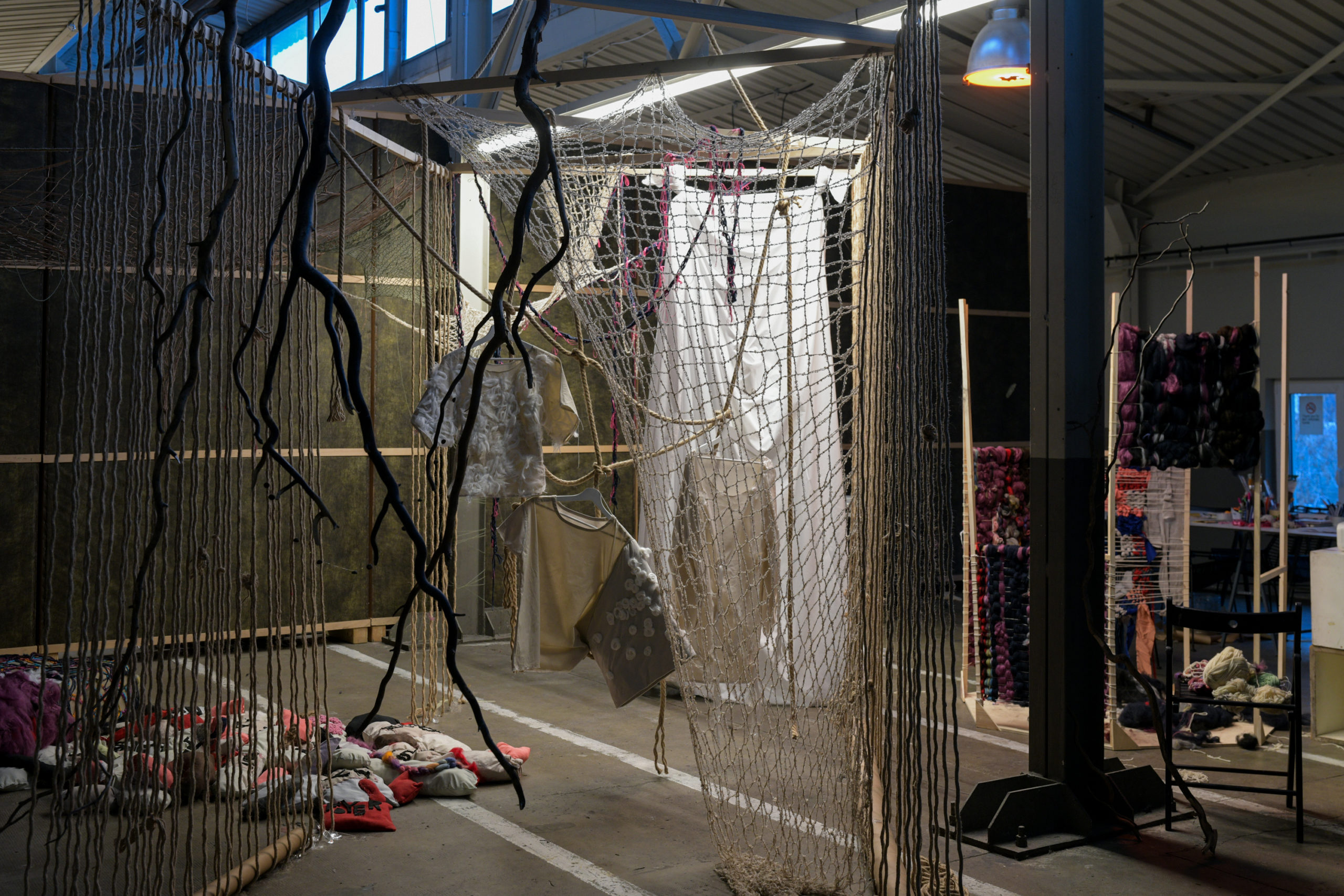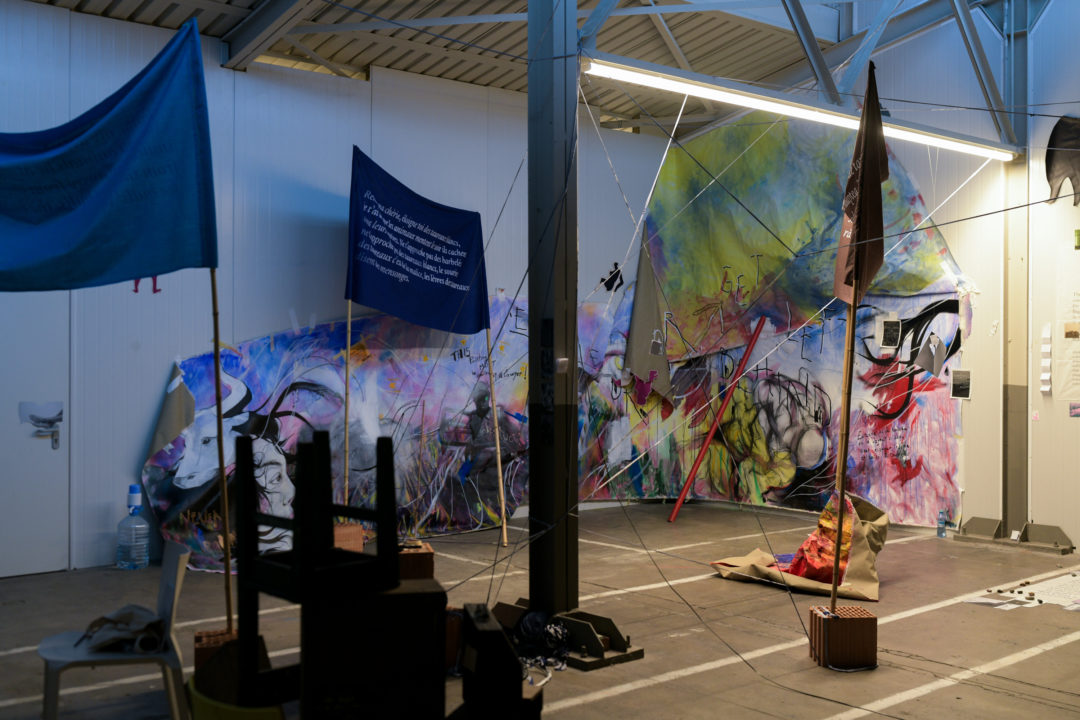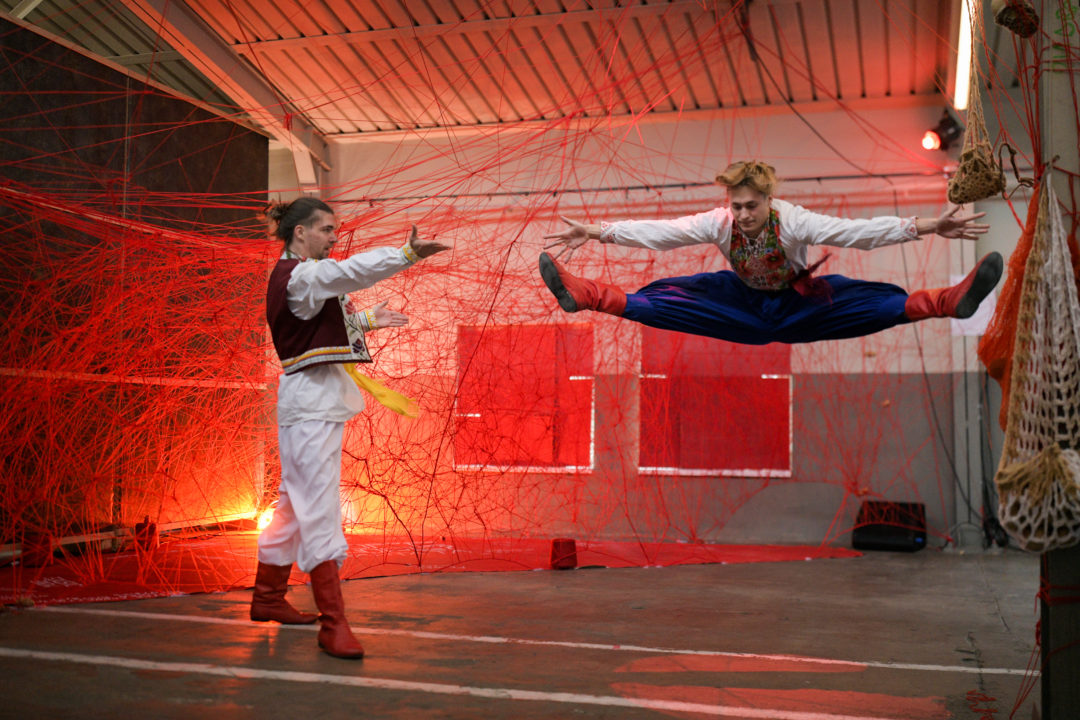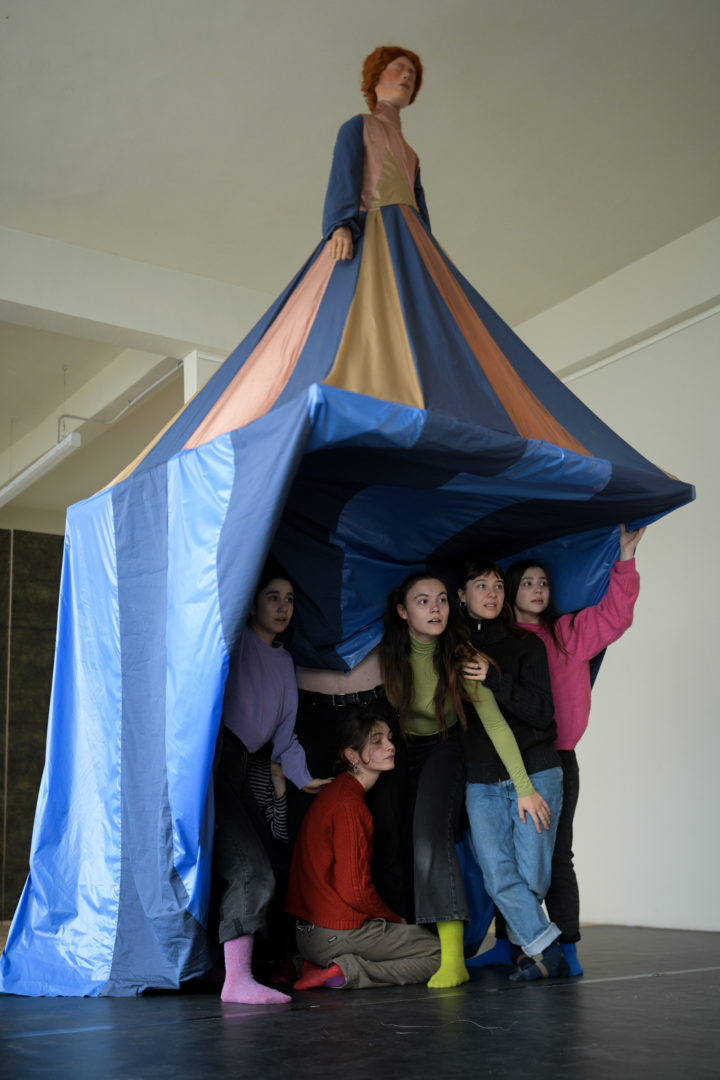EuroFabrique In Romania

EuroFabrique, Do alongside, Do with, Do through, Do together
From December 5 to 10, 2023, 170 students from 19 European art schools gathered in Cluj-Napoca, in a former Romanian shoe factory, a highly symbolic vestige of Communist industry. Assembled in this temporary European art school, divided into working groups, they were responsible for bringing to life and inhabiting the second edition of EuroFabrique, an artistic and educational laboratory. Empirical in nature, at the crossroads of artistic practice, societal reflection, and innovative peace-making processes, it was also an opportunity to collectively experiment with the idea of the European Union, both in its institutional stature and on a more daily basis of living together.
On the eve of the European elections in June 2024, EuroFabrique provides an opportunity to take the pulse of a Europe that some would say is already moribund. The general theme chosen, The Abduction of Europe, brings together as a common ground for questioning, debating, and creating the dark realities Europe is facing: health crisis, climate change, changes to our economies, social conflict, hostility towards immigration, and the growing rise of populism. As we approach the end of 2023, the first electoral surveys conducted by Sopra Steria, Ipsos, Cevipof, and Le Monde are already predicting that far-right lists in France could account for 37% of voting intentions. Added to this, of course, is the war in Ukraine, which, since the Russian invasion on February 24, 2022, has pulled down people’s freedom to choose their future on the western side of Europe, thereby jeopardising the common future of the European Union and its values of peace and solidarity.
Where artistic creation can still serve as a reflective and critical platform, how do these five days of co-creation reflect the different issues that are shaking Europe? What are the plastic repercussions of our collective emotions’ outburst? How could this be an inspiration for European politics and democracy?

A first cluster, made up of the following art schools and universities: George Enescu National University of Arts lasi, Kyiv National University of Culture and Arts, Academy of Music Theatre and Fine Arts Chisinău, École Supérieure d’Art Annecy Alpes, Koeln International School of Design, and École nationale supérieure des arts de Bourges, worked on the idea of unravelling the myth, metaphorically seeking a new name for Europe. A name that would be free of the arbitrary and instrumentalised founding narratives. The workshop and exhibition space had been divided into as many sections as there were schools. Each presented the results of five days of visibly isolated practice. At first glance, this segmentation seemed disconcerting, since where we had expected collective synergy and working together, there was only a clear division of space. Discussions with the students revealed that the collective exercise had come up against the positions taken by each school, stemming from apparently diverse, if not opposing, ways of working. There are differences in the timetable to be followed, in the methodology, and in the plastic forms, leading to tensions that have been solved by a form of least-cost resolution, which is strict spatial sharing and cohabitation.Nevertheless, and despite the antagonisms, it is important to note that no school went so far as to withdraw and that the contractures were relaxed during informal moments of sociability. Perhaps this is a symbolic detail artificially transposed to the European scale, but accepting differences or temporary disagreements does not prevent us from living side by side and trying to find areas of contact.
Indeed, the wire structure built by the Cologne students was activated at times by dancers or performers from other schools. Similarly, the performance written by the École Supérieure d’Art Annecy Alpes was enriched by spontaneous participation.
Perhaps the myth that needs to be undone is one of European horizontality, whereas all countries have neither the same needs nor the same priorities. The students from Kyev and Chisinău, in view of the war in Ukraine and their direct proximity to the conflict, used this forum to reaffirm their identity and their fight against the Russian oppressor through updated traditional songs, music, and dances. Those from the École Supérieure d’Art Annecy Alpes, perhaps visionary or reacting to the growing hostility to immigration in France (culminating in the recent immigration law), proposed a performance based on intimate geography and individual trajectories. Successive and succinct testimonies, associated with the simple gesture of moving a potato for each individual or member of the family, whether natural or chosen.
Fragmentation was justified by these specific realities while at the same time pointing to the underlying trap of sovereignty. This banner of sovereignty is waved by nationalists in every country, with the European Union always demonised and presented as a threat to so-called national identities, even though these are constantly fluctuating and changing. The very existence of heterogeneous sensibilities in the arts, for example, finds its meaning and depth in juxtaposition, cohabitation, and doing things alongside each other.
A second cluster, made up of the following art schools and universities: National University of the Arts Bucharest, École Supérieure d’Art & Design, Le Havre / Rouen, École Supérieure d’Art et Design Valence-Grenoble, and Art Academy of Latvia Riga worked on the notion of walls and borders with a completely different methodological approach. Each student brought material from their own personal practice: videos, drawings, texts, or materials such as large-format canvases to support a collective practice on site. All these elements, micro-participations, were combined into a choral and abundant whole. The exchanges and discussions between the students focused more on the arrangement and spatial placement of these forms, in a necessary conciliation. The exercise of negotiation implied composition and making do : from accepting forms that did not necessarily echo all the participants to superimposing and combining interventions. This proposal opens up reflection on a European scale on two main aspects: the question of borders and that of European demoï.

On the one hand, the process of collecting and pooling all these personal elements is a prosaic illustration of the idea of the free movement of goods and people; plus, the way in which they are organised without segmentation illustrates the openness that exists between the countries in the Schengen area. Where the myth of Europe – daughter of Agenor, abducted and raped by Zeus – is used in xenophobic anti-immigration rhetoric, it is more important to bear in mind the externalisation of European borders and its consequences for individuals who remain stranded or die on the periphery. What happens “outside” our borders is our own business.
On the other hand, this association of plastic forms is a micro-laboratory for democratic practice on a European scale. Without falling into the illusion of a popular dilution with the formation of a new united and singular European people, the model tested is rather that of a construction by association of singularities, demoï according to a “European social contract”, rules and rights of deliberation, exchange, and justice common to all.
A third cluster, made up of the following art schools and universities: Babes-Bolyai University of Cluj-Napoca, Faculty of Theatre and Film – I.L. Caragiale National University of Theatre and Cinema Bucharest, École des arts décoratifs Paris, and the University of Florence worked on reinterpretations of Orpheus and Eurydice’s myth. Here again, the collective method differs from the other two, opting for takeover and technical specialisations. Based on the two myths, the schools divided up their work according to their own skills. The Florence students, whose training was more theoretical, began by researching the history of theatre and the iconography of the myths. They then passed on their observations to the École des arts décoratifs Paris, which produced costumes and scenographic elements, which were then passed on to students from two other schools in Cluj-Napoca and Bucharest for performance interpretation. The chosen methodology highlights the idea of cooperation and passing it on, but it could also be seen as putting into practice a socialist ideal and its adage “from each according to his means, to each according to his needs”.
The contemporary questioning of myths led them to Kate Tempest’s song Europe is lost, in which she makes a terrible but truthful assessment of all of Europe’s current ills. While Orpheus turns back to look behind him, for the singer, Europe is not turning back and has cut itself off from its past: “We have learned nothing from history”.
One of the performances on show was particularly moving, touching on the ambivalent nature of the desire for Europe. A costume-architecture, a dress that was both a house and a puppet, in aquatic blue tones, was activated by choreography. Four dancers moved inside or outside this textile wave, going through contradictory emotions between envy and fear. This duality between insider and outsider can be interpreted in two ways: on a national scale, when a country joins or leaves the European Union; and on an individual scale, when the migratory journey towards Europe holds as many hopes as dangers. European belonging, whether political, societal, or spatial, highlighted here in a mythological legacy, can be put in dialogue with Paul Ricoeur’s notion of narrative identity, such that the identity of a subject cannot subsist in time without the dimension of ipséité, i.e., the voluntary affirmation of oneself before others. In other words, the feeling of being European is the result of a narrative that can and must vary and be reconfigured in response to current factors and the new challenges we face, an ambivalence and fertile instability.

Finally, the last cluster, made up of the University of West Timisoara Faculty of Arts and Design, Haute école des arts du Rhin, École des Beaux-Arts de Nantes, University of Beira Interior Covilhã, and Brera Academy of Fine Arts Milan, worked on the notion of EuroTales, using an equally singular methodology. An initial collective brainstorming session covered the walls with ideas, concepts, and key words for everything that the European umbrella encompasses, including abstractions and facts. Then the thread took over from the words, and everyone made the most of the remaining time to weave together, discover, and pass on specific techniques. The continuity between language and weaving became intertwined, both as a way of thinking and as a way of acting. Isabelle Marchesin (INHA), in a lecture given as part of the seminar L’art médiéval est-il contemporain? at the BNF, dwells for a moment on the motif of interlacing and its physical and metaphysical characteristics.
In the first place, interlacing implies fragmentary knowledge, with each strand appearing only in fragmentary form and disappearing in the interweaving. A perfect image of the interweaving of individualities. It requires a “cognitive distance, because we can only understand the ordering of the interweave by following each of its strands, and by following the strands individually, we then lose sight of the whole”. Finally, like artistic creation, particularly that of the students, the interweave has no fixed form and no real fixed boundaries. On the contrary, what escapes the gaze that follows the interlacing is filled in by the imagination, the off-field constitutes a space of its own. The pattern of interlacing would then be offered as another frame of reference, perhaps less worn and abused than other beliefs such as diversity. The European legend must be able to regenerate itself and update its foundations.
The occupation of space and time by these different textile sculptures and the wire architecture can also be read as a plastic embodiment of Ursula K. Le Guin’s The Carrier Bag Theory of Fiction. The feminist science fiction writer proposes a different framework for understanding and telling the stories of history. In a reversal of the tools available to advance history, she proposes adopting the point of view of the picking bag rather than the phallic spear. Past history and the history yet to be written can then be freed from the glorification of the hero, necessarily masculine and conquering, to make way for the prism of the container, from the shell to the canvas bag. The installation created by the students in this latest cluster allowed us to enter this container, welcoming the possibility of transforming our schemas and frames of reference.
1 Céline Spector, Une Europe sans peuple ? Les conditions d’une démocratie européenne, AOC, jeudi 21 octobre 2021
2 Paul Ricoeur, Temps et récit, Seuil, 1983-1985
From 5 to 10 December 2023, EuroFabrique Cluj is organised by the Transylvanian Creative Industries Cluster, the French Institute of Romania Cluj-Napoca and MushuROI, in partnership with ANdÉA.
______________________________________________________________________________
Head image : EuroTales, EuroFabrique Cluj, 2023 @ Stefan Badulescu, EuroFabrique Cluj, December 2023
- From the issue: 107
- Share: ,
- By the same author: Moffat Takadiwa, Stanislas Paruzel at 40mcube, June Crespo, Mathilde Rosier et Ana Vaz at CRAC Altkirch,
Related articles
Streaming from our eyes
by Gabriela Anco
Don’t Take It Too Seriously
by Patrice Joly
Déborah Bron & Camille Sevez
by Gabriela Anco

